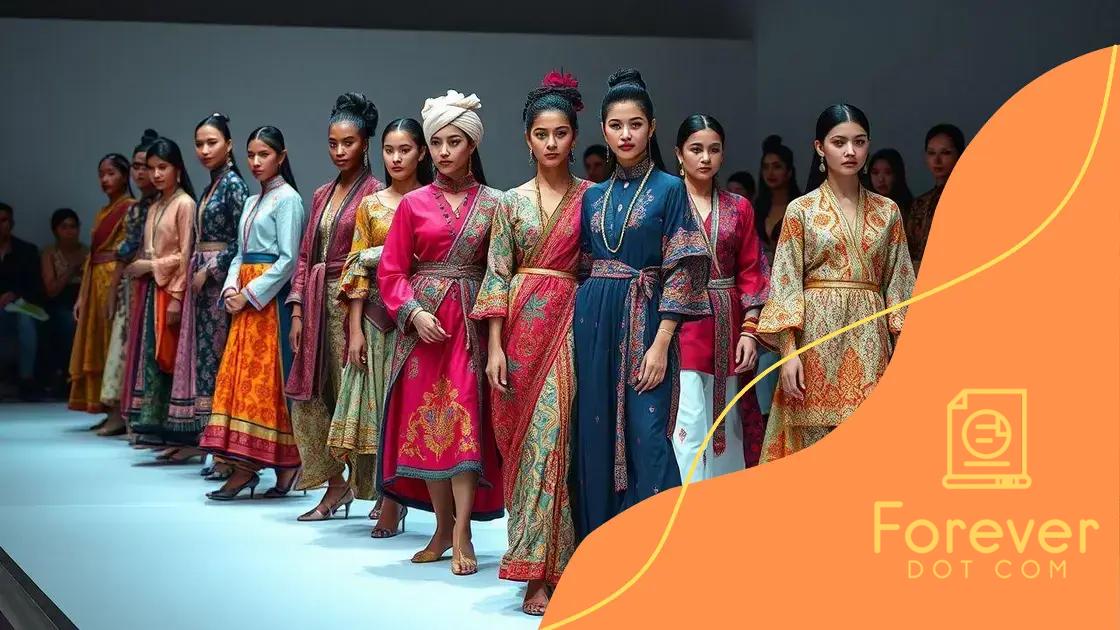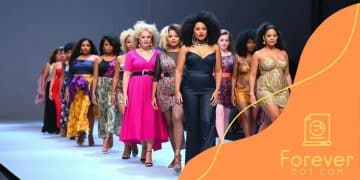How cultural diversity enriches fashion modeling

How cultural diversity enriches fashion modeling by fostering inclusivity, challenging beauty standards, and inspiring new styles through the representation of models from various backgrounds, ultimately transforming the industry.
How cultural diversity enriches fashion modeling is a question worth exploring. With a mix of backgrounds, the industry opens up a world of vibrant styles and innovations. Have you considered how this diversity impacts what we see on the runway?
Understanding the impact of cultural diversity in fashion
Understanding the impact of cultural diversity in fashion is essential for appreciating the richness that different backgrounds bring to the industry. Fashion thrives on creativity, and diverse influences lead to innovative designs that reflect a wide array of experiences and perspectives.
The Importance of Representation
Having models from various cultures helps to ensure that all voices are heard. When fashion houses display a range of models, they not only embrace diversity but also make connections with a broader audience. This representation can lead to greater inclusivity and acceptance in the industry.
How Cultural Influences Shape Fashion
Cultural elements such as colors, patterns, and styles significantly influence fashion trends. For example, traditional garments from different regions can inspire modern collections. By incorporating these influences, designers can tell a story that celebrates their heritage.
- Diverse fashion shows highlight unique aesthetics.
- Different cultural elements can inspire global trends.
- Inclusive marketing attracts a wider customer base.
Moreover, understanding cultural differences enables designers to create collections that resonate more deeply with diverse consumers. When a collection echoes cultural themes, it not only appeals aesthetically but also emotionally.
Incorporating diversity enriches the entire fashion ecosystem. It challenges designers to think outside the box and embrace the beauty of various traditions. Such diversity fosters innovation and leads to groundbreaking fashion that captivates audiences worldwide.
Ultimately, recognizing the impact of cultural diversity in fashion allows for a more vibrant and dynamic industry. The future of fashion lies in its ability to embrace all cultures and promote a sense of belonging for everyone.
The role of representation in modeling
The role of representation in modeling is crucial for creating a fashion industry that truly reflects the world we live in. When models of different backgrounds are showcased, it opens doors for greater acceptance and diversity in fashion. Representation matters because it inspires individuals from all walks of life to see themselves in the garments that grace the runway.
Empowerment Through Visibility
Models from diverse backgrounds can empower others simply by being visible. Their representation in campaigns and runway shows shows that beauty is not confined to one standard. This visibility allows aspiring models to feel validated and encouraged to pursue their dreams.
Shaping Consumer Perceptions
When brands prioritize representation, they shape consumers’ perceptions and preferences. An inclusive approach makes products appealing to a broader audience, creating a positive atmosphere around the brand. Consumers feel connected to brands that represent them, fostering loyalty and engagement.
- Brands that feature diverse models receive positive social media attention.
- Informed consumers tend to support brands promoting inclusivity.
- More representation can lead to healthier beauty standards in society.
Additionally, by representing a variety of cultures and identities, the fashion industry can move away from outdated norms. It paves the way for new standards of beauty that celebrate individuality and uniqueness. Inclusion invites collaboration amongst cultures, leading to richer and more vibrant fashion narratives.
Brands that embrace diversity not only benefit from an enriched consumer base but also contribute to a cultural shift. Consumers start expecting to see a range of identities represented in their favorite brands. This shift not only enhances the industry but also influences how individuals view their own worth and beauty.
How diverse backgrounds influence fashion trends

How diverse backgrounds influence fashion trends is a fascinating aspect of the industry. Different cultures bring unique perspectives, which are reflected in the styles, colors, and materials that designers choose. When designers embrace these influences, they create collections that resonate with a wider audience and tell powerful stories.
Cultural Inspirations
Many fashion trends originate from traditional clothing styles. For instance, elements from African textiles, Asian silk, or Indigenous patterns add depth to modern designs. These cultural inspirations lead to clothing that is not only fashionable but also rich in heritage and meaning.
Emergence of New Styles
The blending of various cultural influences often leads to the emergence of entirely new styles. When designers collaborate with artists from different backgrounds, they fuse their creative insights to innovate. This collaboration can result in groundbreaking trends that challenge conventional fashion norms.
- Diverse collaborations create unique collections.
- Global exposure influences designer creativity.
- Mixing traditional and modern elements attracts interest.
Moreover, the rise of social media has made it easier for diverse trends to gain recognition. Influencers from all walks of life share their interpretations of fashion, making it accessible to more people. As a result, styles that may have been considered niche can become mainstream, further highlighting the significance of cultural diversity.
As consumers celebrate their heritage, brands must respond to this desire for representation in their collections. Designers who respect and incorporate cultural significances into their work cultivate deeper connections with their audience. When consumers see their culture reflected in fashion, it generates a sense of pride and belonging, making them more likely to support the brand.
Case studies of successful diverse models
Case studies of successful diverse models highlight how representation can transform the fashion industry. These individuals not only broke barriers but also set new standards for beauty and success, inspiring future generations to embrace their unique identities.
Modeling Icons Breaking the Mold
Models like Naomi Campbell and Liu Wen have redefined the fashion landscape. Naomi Campbell, one of the first Black supermodels, has paved the way for many. Her career spans decades and showcases the importance of diversity. Meanwhile, Liu Wen, known as the first Chinese model to gain worldwide acclaim, showcases the growing acceptance of diverse backgrounds in high fashion.
Emerging Talents Shaping the Future
New faces like Halima Aden have also made waves by challenging traditional beauty norms. As a Somali-American model, Halima was one of the first to wear a hijab on the runway. Her presence has opened doors for other models with different backgrounds to follow suit, proving that fashion is for everyone.
- Diversity in modeling promotes inclusivity.
- Successful models can influence brand representation.
- Emerging talents inspire young individuals to pursue modeling.
Additionally, brands are increasingly showcasing models of varying sizes, ages, and backgrounds. This shift reflects a broader understanding of beauty that embraces imperfections and unique features. Models like Ashley Graham have become champions for body positivity, making significant strides in the industry.
These case studies not only celebrate the achievements of individual models but also highlight ongoing challenges and the need for further advancement. Many successful diverse models continue to advocate for greater representation, challenging the status quo and promoting a more inclusive industry.
Challenges faced by models from different cultures
Challenges faced by models from different cultures can significantly impact their careers and experiences in the fashion industry. Despite the growing push for diversity, many models encounter obstacles that can hinder their success.
Discrimination and Stereotypes
One major issue is discrimination based on race or ethnicity. Many models report facing stereotypes that limit the types of roles they are offered. Instead of being seen for their unique talent, they may find themselves boxed into specific categories based on misconceptions about their culture.
Limited Opportunities
Another significant challenge is the lack of representation in major fashion campaigns and runway shows. Models from diverse backgrounds often struggle to land high-profile gigs, which can limit their visibility in the industry. As a result, they may not receive the same professional opportunities as their peers.
- Many diverse models miss out on contracts and brand endorsements.
- Fashion shows often lack diversity in casting.
- Industry standards can overlook cultural aesthetics.
Furthermore, cultural differences can pose challenges when models are expected to fit into a specific mold. Many are pressured to conform to Western beauty standards, which may not represent their authentic selves. This pressure can affect their mental health and self-esteem.
Support from organizations and advocacy groups is vital to address these challenges. Increasing awareness of the unique struggles faced by models from various backgrounds can lead to improved practices within the industry. Additionally, having mentors who understand their experiences can provide guidance and encouragement.
FAQ – Frequently Asked Questions about Cultural Diversity in Fashion
Why is cultural diversity important in fashion?
Cultural diversity is essential in fashion because it enriches the industry, brings new perspectives, and helps to create a more inclusive environment that reflects the world we live in.
What challenges do models from diverse backgrounds face?
Models from diverse backgrounds often face discrimination, limited opportunities, and pressure to conform to specific beauty standards, which can affect their careers.
How can representation in fashion improve inclusivity?
Representation in fashion allows more people to see themselves in the industry, which encourages diverse talent and promotes acceptance of different styles and identities.
Who are some successful diverse models?
Successful diverse models include Naomi Campbell, Liu Wen, and Halima Aden, who have all made significant contributions to promoting inclusivity and diversity in fashion.






